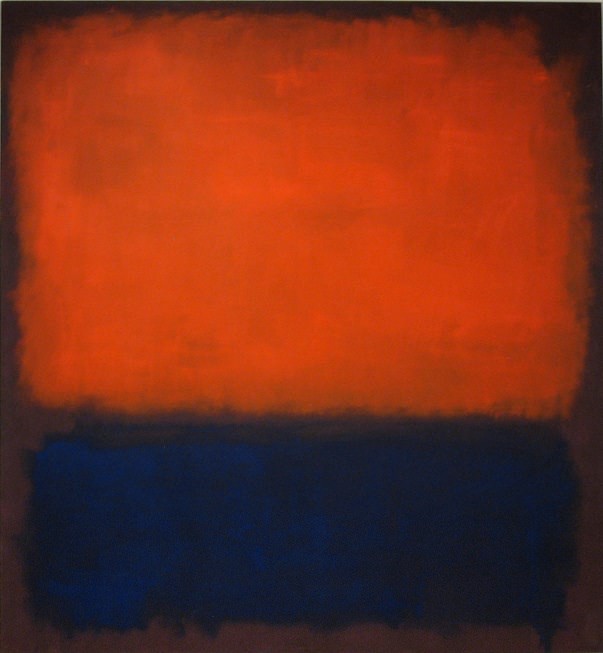The Value of Art
I recently realized that I’ve been thinking about art – especially modern art – in the wrong way. Up until a few weeks ago, my biggest problem with modern art was that people try to extract too much meaning out of too little content. Can Rothko’s painting of two fuzzy rectangles really capture the depths of human emotion? This seems to violate some law of conservation of information. The way I saw it, you really only need a couple hundred bits (0s and 1s) to represent certain Rothko paintings1 – the same amount of information as a couple of sentences of English text2.

Rothko's Number 14.
Can the depths of human emotion really be evoked with the information contained in a couple of well-written sentences? Maybe, but I’ve always been skeptical. To me, it seemed that most of the meaning extracted from modern art pieces came from the critic themself as they somehow projected their own views on society/humanity/life onto the piece. This is not bad, it just means that the value resides less in the artwork and more in the critic.
Put differently, I thought that most of the appeal of modern art was placebo. The desire to think that something is meaningful makes it feel meaningful.
But then I visited Laurie Anderson’s exhibit The Weather at the Hirshhorn Museum in Washington, D.C. I was overcome with fear while walking through Salute, a dark hallway of red flags waved in unison by robotic arms set to ominous droning. I was struck with wonder and nostalgia in Four Talks, an entire room covered with cryptic graffiti holding four odd sculptures. I am quite confident that this fear, wonder, and nostalgia were not placebos. Experiencing this art evoked substantive emotions in my mind.


Anderson's Salute and Four Talks. My photos do not do them justice.
This is when I began to realize that I had been thinking about art in the wrong way. Instead of treating a piece of art as a mysterious capsule that carries intrinsic value for being “beautiful” or “meaningful,” I should treat it simply as an object that has the power to evoke emotion in a human brain. The value of a piece of art does not come from it being beautiful, but rather from it appearing beautiful to people, which has the concrete effect of altering their mood and causing change in the world. Consider a magnificent sculpture. It might be true that this sculpture has some inherent “beauty value” to the universe, independent of how many people view it. This is something philosophers should, and do, think about. But even if it isn’t true, we can still value the sculpture for its effect on the people who look at it.
My point here is that we get a lower bound on the value of a piece of art by adding up the total emotion that it evokes in viewers. A friend explained to me that this is called a “consequentialist” view of art3. I personally think this makes a lot of sense. As a society, we pay lots of money on mood-affecting objects like movies and books (which make us happy or sad or scared, depending on the genre) because we enjoy feeling these emotions. This gives movies and books value. So if art can produce similar emotions, it should also be valuable, regardless of whether it carries some higher meaning.
This is not to say that I’ve suddenly become a fan of all modern art. In fact, most of the artwork in Laurie Anderson’s exhibit just seemed weird to me. But even if a piece of art only speaks to one in ten viewers on a moderately deep level, that already gives it the potential to moderately affect the emotions of 800 million human beings! Considering the fact that it only takes a few minutes to look at a piece of art (compared to over an hour for a movie), this presents a pretty efficient source of emotional value. So if you feel that art is overblown – that a universe composed of dead atoms can’t possibly derive any value from a couple of fuzzy rectangles – I invite you to consider this consequentialist mindset. And if you’re skeptical that any modern art can have an emotional effect in the first place, check out some of the pieces by Laurie Anderson. She’s the one who convinced me.
-
There’s basically a maximum of four different colors (taking three bytes each), only two different rectangular shapes (four bytes each to encode their coordinates), and then to be safe you can add on a couple more bytes to encode different levels of fuzziness. It seems unlikely that any information not included in this encoding, like slight variations in hues and textures, plays a significant role in constructing meaning. ↩
-
Assuming that English has around one bit per character of entropy. ↩
-
I see lots of parallels between the consequentialist view of art and the consequentialist view on morality (such as hedonistic utilitarianism). Under both theories, we choose to assign artistic/moral value to art/actions because of their ability to affect conscious brain states, not because there is intrinsic beauty/goodness in the art/actions themselves. ↩